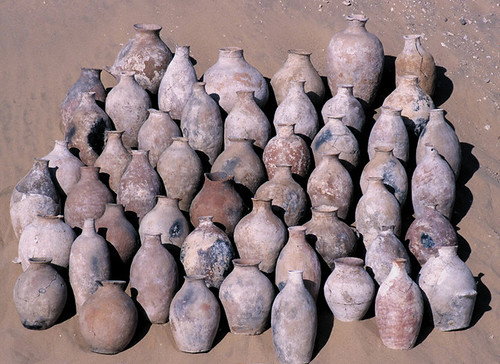Ceramic Technology: The Inorganic Perspective

- A representative sampling of the ca. 700 wine jars from the Scorpion tomb. (Photograph courtesy of German Institute of Archaeology, Cairo.)
Before our laboratory embarked upon organic residue analyses to find out what ancient vessels contained, our focus was the inorganic containers themselves and how they were made from fired clay and silicate materials.
The form and decorative details of a pottery vessel are the end-products of a complex industrial sequence. The process begins with the selection and preparation of raw materials (clay and temper) and continues through a variety of formation techniques (e.g., definition of the body of the vessel, trimming of the rim and base, and the attachment of handles and appliqués), surface finishing (such as smoothing. slipping. or painting), and firing.
A standard typological analysis of an archaeological corpus assumes that the potter’s primary goal was to produce a particular form, which had been established by conscious and unconscious cultural traditions. From this perspective. pottery served definite functions within a society, whether as utilitarian or prestige items, and changes in style are seen as reflecting changes in the society as it interacted with its environment and other societies.
The emergence and subsequent development of a stylistic tradition. however, is conditioned by and can be very much dependent on underlying technological traditions. In general, any stage in the industrial sequence may impact on another stage in the same sequence. For example, the unavailability of high-quality raw materials or limited expertise in their preparation might inhibit the development of a wheel-throwing tradition. Form can also be a function of the decoration that is envisioned, whether expanding the shoulder space on a vessel for more elaborate painting or making a more open form that can be more efficiently slipped and painted.
In most cases, only finished pottery is available for study, which places a premium on complementary analytical techniques that can provide various kinds of data from which inferences can be drawn about the·production stages. If the ancient pottery manufacturing installations can be found or if the original raw materials are known, then the industrial sequence can be much more convincingly established, in conjunction with replicative experiments.
In the Molecular Archaeology Laboratory, a routine procedure has been developed for analyzing a corpus of pottery. The initial problem, especially for a group of finished pottery vessels, is to select a representative collection of specimens from a much larger corpus. The crucial factors at this stage will be primarily macroscopic criteria (vessel form, surface decoration, ware color, etc.), bearing some relation to the manufacturing process, and the results of previous investigations. Low-power microscopic observation (using a stereozoom scope with fiberoptic lighting, up to x 180) was an important adjunct in preliminarily defining wares, and formation and finishing methods. Specific ceramic questions are also posed at this level of analysis. The pilot study may resolve some of these questions: depending upon the analytical results, other questions may have to be recast or the sample size enlarged (which might be indicated by feedback arrows on the flow chan). As technological interpretations are progressively refined, cultural inferences are correspondingly strengthened.
It is most convenient initially to separate the xeroradiographic study of fabrication methods from the petrographic analysis. Although it is desirable to study many of the same samples by a combination of analytical. techniques, additional larger specimens from specific parts of a vessel, in particular the rim and base where there was the inevitable problem of what to do with excess or insufficient clay, often need to be X-rayed. The interpretation of inclusions and voids on a radiographic image can also be ambiguous, e.g., the lighter mineral inclusions such as calcite and quartz are essentially transparent to the X-ray beam (non-radiopaque) and indistinguishable from voids (except in the case of more angular shapes).
The petrographic analysis bears most directly upon the refiring and scanning electron microscopic (SEM) studies of the original firing temperature range, structural and chemical ware properties, and surface decorations (slips, paints, etc.) of the ancient pottery. For example, specific mineralogical changes, such as the transformation of green to brown hornblende at ca. 750̊C, provides evidence of the original firing temperature, and ware types are partly defined by their mineral suites. On this basis, a group of samples, representative of a ware type, was refired over a specific temperature range to delimit the original firing range for that ware type. Slips and other surface layers are best characterized structurally and chemically by SEM; their presence/absence, however, can often be established under low-power magnification by color and structural differences as contrasted with the body ware.
Our ancient ceramic program also routinely includes heavy mineral analysis, Instrumental Neutron Activation Analysis and X-ray diffraction–techniques that provide unique sets of data. It might also be argued that an ethnographic study of modern potters in the region under study is an essential component in reconstructing the ancient ceramic technology and its cultural import.
A separate analytical program has been developed for ancient silicates, employing SEM and PIXE for colorant identification.
Our laboratory has studied silicate and pottery artifacts from around the world, e.g., the Middle East (Baq`ah Valley in Jordan and Beth Shan in Israel; Dinkha Tepe in Iran), South America (Batan Grande in Peru), southeast Asia (Ban Chiang in Thailand), etc.
Please refer to the numerous Articles and Books on these subjects.

Leave a Reply
You must be logged in to post a comment.